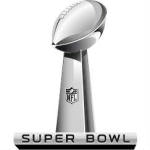Super Bowl IX: Pittsburgh 16-6 Minnesota
AFC champion Pittsburgh, in its initial Super Bowl appearance, and NFC champion Minnesota, making a third bid for its first Super Bowl title, struggle through a first half in which the only score is produced by the Steelers’ defense when Dwight White downs Vikings’ quarterback Fran Tarkenton in the end zone for a safety 7:49 into the second period. Pittsburgh’s defense permits Minnesota only 119 yards total offense, including a Super Bowl low of 17 rushing yards. The Steelers, meanwhile, gain 333 yards, including Harris’s record 158 yards on 34 carries.
Super Bowl VIII: Miami 24-7 Minnesota
The defending NFL champion Dolphins, representing the AFC for the third straight year, score the first two times they have possession on marches of 62 and 56 yards, while the Miami defense limit the Vikings to only seven plays in the first period.
Super Bowl VII: Miami 14-7 Washington
The Dolphins play virtually perfect football in the first half as their defense permits the Redskins to cross midfield only once and their offense turns good field position into two touchdowns.
Super Bowl VI: Dallas 24-3 Miami
The Cowboys rush for a record 252 yards and their defense limits the Dolphins to a low of 185 yards while not permitting a touchdown for the first time in Super Bowl history.
Super Bowl V: Baltimore 16-3 Dallas
A 32-yard field goal by rookie kicker Jim O’Brien brings the Baltimore Colts a victory over the Dallas Cowboys in the final five seconds of the game. This is the first Super Bowl played on artificial turf for the first time.
Super Bowl IV: Kansas City 23-7 Minnesota
The AFL ties the Super Bowl at two games apiece with the NFL with Kansas, building a 16-0 halftime lead. Dawson, the fourth consecutive quarterback to be chosen the Super Bowl’s top player, plays an almost flawless game, completing 12 of 17 passes and hitting Otis Taylor on a 46-yard play for the final Chiefs touchdown. The Kansas City defense limits Minnesota’s strong rushing game to 67 yards and has three interceptions and two fumble recoveries. The crowd of 80,562 sets a Super Bowl record, as do the gross receipts of $3,817,872.69.
Super Bowl III: New York 16-7 Baltimore
Jets quarterback Joe Namath “guarantees” victory on the Thursday before the game, then goes out and leads the AFL to its first Super Bowl victory over a Baltimore team that had lost only once in 16 games all season.
Superbowl II: Green Bay 33 – Oakland Raiders 14
0 CommentsGreen Bay wins the Super Bowl title for the second straight year, after winning its third consecutive NFL championship. They defeat the Raiders – the AFL champion – in a game that drew the first $3-million gate in football history. Bart Starr is the MVP again, completing 13 of 24 passes for 202 yards and one touchdown. The Packers’ attack is in control all the way after building a 16-7 halftime lead. Don Chandler kicks four field goals. Herb Adderley caps the Green Bay scoring with a 60-yard interception return. Vince Lombardi ends nine years as Packers coach, having won six Western Conference championships, five NFL championships, and two Super Bowls.
Superbowl I: Green Bay 35 – Kansas City 10
0 CommentsThe first Superbowl is held in at the Los Angeles Memorial Coliseum between the Green Bay Packers and AFL champions, the Kansas City Chiefs. Green Bay get three second-half touchdowns, the first of which is set up by Willie Wood’s 50-yard return of an interception. Max McGee catches seven from Bart Starr for 138 yards and two touchdowns. Elijah Pitts runs for two other scores. The Chiefs’ 10 points come in the second quarter, the only touchdown on a 7-yard pass from Len Dawson to Curtis McClinton. Starr completes 16 of 23 passes for 250 yards and two touchdowns and is chosen the most valuable player.
Final score is Green Bay 35, Kansas City, 10. The Packers collect $15,000 per player and the Chiefs $7,500, the largest single-game shares in the history of team sports.
